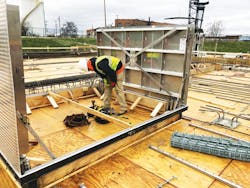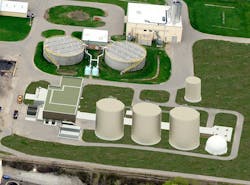The city of Grand Rapids, Mich. built its wastewater treatment plant in 1931, and was among the first in the nation to include a biodigester. The system worked until the late 1970s, when increased industrial waste and inefficient performance compelled the city to close it.
In 2018, the city began building a $57 million biodigester that will convert food waste to energy and increase energy efficiency. The project, which is expected to be complete in fall 2019, is part of the city’s solution to use 100 percent renewable energy to power city buildings by 2025.
The Grand Rapids plan will take organic waste and combine it with microorganisms in three sealed, air-tight tanks that have a capacity of 1.4 million gallons. Two tanks will be used for municipal biosolids, and the other tank is an anerobic membrane bioreactor to quickly reduce other organic waste, such as that from Founders Brewery, one of the most prominent breweries in Michigan. The biodigesters will convert carbon to carbon dioxide and methane. The biogas produces energy, primarily electricity, that can be used to power and heat the buildings and operations at the city’s Water Resource Recovery Facility.
Waste will filter to the biodigester from businesses in the Grand Rapids commercial district through a 10-inch transmission pipe that will carry concentrated food waste from Founders and other businesses to the treatment plant. The waste will then be recycled through the biodigester to create the biogas.
The biodigester includes a substantial number of pumps and other mechanical equipment that require access for repair and inspection. The project’s contractor, The Christman Company, selected 19 products from The BILCO Company, including floor doors and roof hatches, that will allow workers access to equipment when the biodigester becomes operational. Architectural Building Products of Byron Center, Mich., provided the doors.
“BILCO provides a wide range of sizes that we need and could deliver to the project on time, including very large custom-built units,’’ said Eric Sawatzki, the assistant project manager. “A really appealing feature is the fall protection grating option for our standard-sized floor openings. This provides immediate protection from falls through the floor opening for construction personnel as well as users at the plant. It saves the expense of installing a rail system around every opening.”
The doors feature aluminum construction and stainless-steel hardware for corrosion-resistance and engineered lift assistance for one-hand operation. The safety grate includes a safety-yellow powder coat paint finish, and stainless-steel hardware as well. In addition to the floor access doors, the project also included several BILCO roof hatches with safety railings to access roof areas throughout the facility.
“As energy recovery becomes more valuable, a lot of other communities will be looking at biodigesters,’’ said Mike Lunn, the Grand Rapids Utilities Director. “We’ve always been engaged in resource recovery. This is a project that could be a template for a lot of other communities.”
Editor's Note: Scranton Gillette Communications and the SGC Water Group are not liable for the accuracy, efficacy and validity of the claims made in this piece. The views expressed in this content do not reflect the position of the editorial teams of Water & Wastes Digest, Water Quality Products and Storm Water Solutions.

